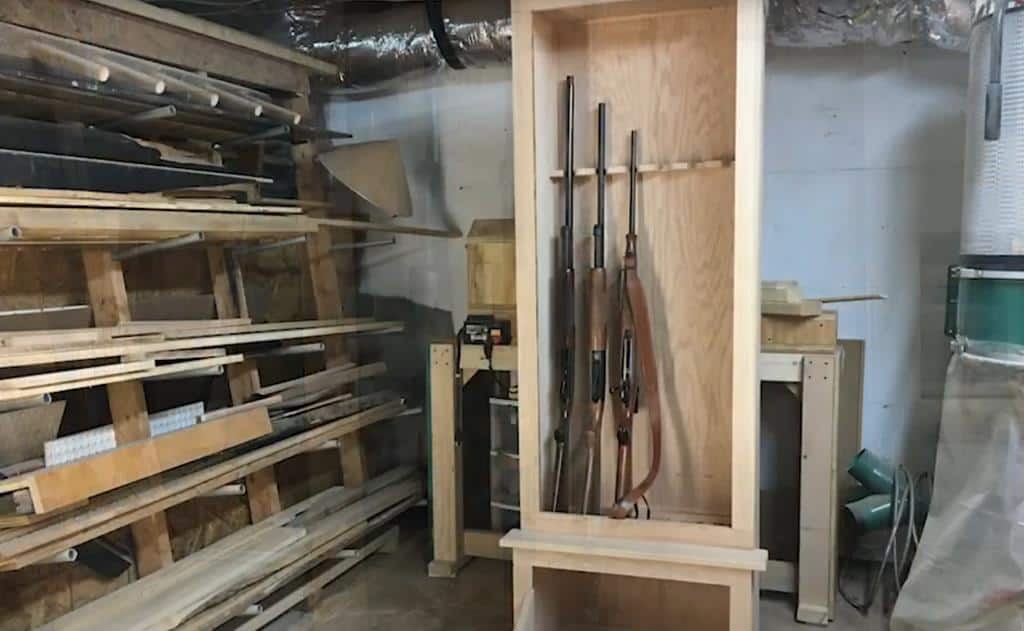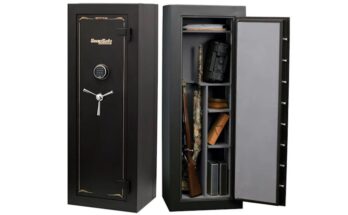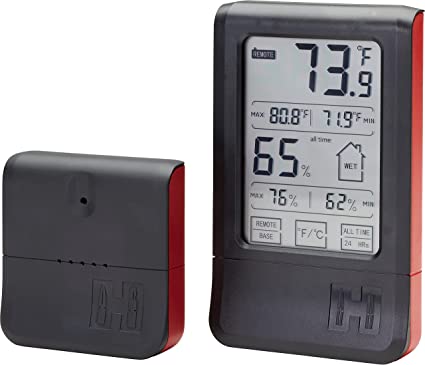To build a wooden gun cabinet, gather materials such as plywood, screws, and wood glue. Next, create a plan that includes precise measurements and safety features.
Building a gun cabinet out of wood requires a blend of carpentry skills, attention to detail, and a focus on safety. Gun enthusiasts and woodworkers often undertake this project to ensure their firearms are securely stored yet accessible. A well-constructed wooden gun cabinet not only serves as safe storage but can also be a display piece in your home.
Crafting it from scratch allows for customization in size, style, and security measures to meet specific needs. Before starting, it’s essential to have a clear design in mind and to familiarize yourself with local laws regarding firearm storage, ensuring your cabinet complies with all regulations. It’s not just about aesthetics; the cabinet must offer tamper-proof locks and robust construction to be truly effective. Joinery, durability, and a secure locking system are paramount in the creation of a solid wooden gun cabinet.

Credit: www.libertysafe.com
Embarking On The Diy Gun Cabinet Journey
Creating your own wooden gun cabinet is an exciting project that combines carpentry skills with the satisfaction of building something both useful and impressive. This project not only adds a personalized touch to your home but also ensures that your firearms are safely stored. Whether you’re a seasoned woodworker or a DIY enthusiast looking to upgrade your skill set, this guide will help you craft a beautiful and functional gun cabinet out of wood.
Essential Tools And Materials For A Wooden Gun Cabinet
To start your woodworking project, gather the proper tools and materials. Here is what you will need:
- Measuring tape – For precise measurements.
- Saw – A circular saw or table saw is ideal for cutting wood.
- Drill with drill bits – For creating holes for screws.
- Screwdriver – To connect pieces with screws.
- Wooden boards – Choose a durable wood like oak or maple.
- Screws and hinges – Necessary for assembly and door operation.
- Wood glue – For reinforced bonds between pieces.
- Sandpaper or a sander – To smooth the wood surfaces.
- Wood finish – To protect and beautify the cabinet.
- Lock – For securing the cabinet’s contents.
All materials should be selected for quality and durability to ensure a long-lasting cabinet.
Safety Considerations Before You Start
Woodworking requires attention to safety. Follow these tips for a safe DIY experience:
- Wear protective gear such as safety glasses, gloves, and ear protection.
- Ensure your workspace is well-ventilated especially while applying wood finish.
- Keep tools in good condition and use them as intended.
- Be mindful of sharp edges and power tool safety.
- Always secure your materials to prevent slipping while cutting.
- Store your tools properly when not in use to prevent accidents.
Remember, taking your time and focusing on safety will not only make your DIY journey enjoyable but also successful.

Designing Your Wooden Gun Cabinet
Creating a wooden gun cabinet combines craftsmanship and safety. Wood provides a naturally sturdy and aesthetic housing for firearms. The design process is crucial for a custom cabinet that meets personal needs.
Deciding Dimensions Based On Your Firearm Collection
Measure your guns first. Length, width, and height matter. Let’s plan a cabinet size. Here’s a guide:
- Rifles and Shotguns: Taller compartments are a must.
- Handguns: Smaller shelves or drawers work.
- Extra Space: Plan for future additions.
Consider wall space. Ensure the cabinet fits well. Add clearance for doors to open.
Choosing The Right Type Of Wood For Durability And Aesthetics
Wood choices affect looks and strength. Each type has unique qualities.
| Wood Type | Pros | Cons |
|---|---|---|
| Oak | Durable, Classic Look | Heavier, Pricier |
| Pine | Lighter, Budget-Friendly | Prone to Scratches |
| Maple | Tough, Fine Grain | Can be Expensive |
Think about your home decor. Match the wood to your style. Hardwoods like oak resist wear. Pine is great for painted cabinets. Maple offers a smooth finish.
Cutting And Assembling The Cabinet Frame
Building a gun cabinet from wood requires precision and attention. The cutting and assembling of the cabinet frame are crucial steps. A sturdy, well-constructed frame ensures the cabinet can securely store firearms.
Step-by-step Guide To Cutting The Wood
Prepare the materials and gather the necessary tools. Here is a systematic approach to cutting:
- Measure and mark the plywood for sides, top, bottom, back, and door.
- Use a circular saw or table saw for long, straight cuts.
- For precision, ensure each piece is identical to the plan dimensions.
- Consider a miter saw for angled cuts if your design includes them.
- Sand the edges for a smooth finish.
Techniques For Assembling A Sturdy Frame
A robust frame is key for a durable gun cabinet. Follow these techniques:
- Start with the sides and attach them to the base using wood glue and screws.
- Ensure the structure is squared using a carpenter’s square.
- Attach the top piece to complete the frame’s outline.
- Reinforce the corners with L-brackets for added stability.
- Secure the back panel with nails or screws, making certain it’s flush.
With careful measuring, cutting, and assembly, your frame will be ready to add shelves, the door, and locking mechanisms.
Cabinet Doors And Locking Mechanisms
The cabinet doors and locking mechanisms are crucial elements of a gun cabinet. They ensure your firearms stay secure and out of reach from unauthorized users. Crafting the doors requires precision, and choosing the right locking mechanism is essential for safety. Embarking on this step involves careful consideration of materials, measurements, and security features. Now let’s delve into the process of making the doors and securing them.
Crafting Doors With Care: Tips And Tricks
Building doors for your gun cabinet is not just about aesthetics; it’s about ensuring they are robust and fit well. The right type of wood, such as oak or maple, ensures durability.
- Select quality wood that can withstand wear and tear.
- Measure twice, cut once to ensure accuracy in fitting.
- Use strong hinges that can support the door weight.
Keeping the doors aligned is vital. Utilize a door clamp or a corner jig during assembly to maintain a square and even shape. Be sure to sand the edges for a smooth finish.
Installing Secure Locks For Safe Firearm Storage
Locks play a pivotal role in gun cabinet security. The right lock can deter theft and prevent accidents. Highlighting various locks aids in choosing the most suitable one.
| Lock Type | Security Level | Key Features |
|---|---|---|
| Key Lock | BASIC | Traditional, with keys |
| Combination Lock | MODERATE | No keys needed, programmable |
| Biometric Lock | HIGH | Fingerprint access, quick entry |
| Electronic Lock | HIGH | Digital codes, multiple users |
Installation of locks should be handled with precision. Follow the manufacturer’s guidelines strictly. Ensure proper alignment for the lock mechanism to function without issues. Test the locking system multiple times before finalizing the setup.
Finally, consider adding a secondary lock for enhanced security. Deadbolts or a hidden key lock can prevent unwarranted access. Double-check all locking mechanisms after installation for peace of mind.
Finishing Touches For Functionality And Appearance
Finishing touches enhance both functionality and appearance, making your gun cabinet not only a secure storage space but also an attractive piece of furniture. These final steps ensure longevity and showcase your personal style.
Sealing And Varnishing For Protection
A rugged, wooden gun cabinet needs strong protection. Seal and varnish each wood piece before assembly. This step is vital for wood preservation. The sealing process safeguards the wood from moisture and potential warping. Varnishing adds a durable finish, preventing scratches and damage.
Begin by applying a wood sealant. Let it dry completely. Follow up with a coat of wood varnish. Choose a varnish with UV protection for the cabinet to maintain its color and prevent fading. Apply multiple thin layers, sanding lightly between coats. This will result in a smooth, professional finish.
Customization Options For A Personalized Touch
Personalize your gun cabinet to reflect your style. Start by selecting a wood stain that complements your space. Consider the grain of the wood for the best visual impact. Wood stains deepen the color and enhance the grain, adding character to your cabinet.
Think about adding decorative moldings or trim for extra flair. Install elegant hardware like handles or knobs that match your home’s decor. For a truly unique touch, consider engraving initials or a design into the wood. Finally, install soft interior lighting to highlight your collection.
Tips:
- Test stain colors and varnishes on scrap wood first.
- Always work in a well-ventilated area when sealing and varnishing.
- Personal touches make your cabinet one-of-a-kind.
Maintenance Tips And Best Practices
A well-built wooden gun cabinet can last for generations with the right care. Let’s dive into some essential maintenance tips and best practices to keep your cabinet in pristine condition.
Regular Cleaning And Care For Longevity
Maintaining your wooden gun cabinet is crucial for its longevity. Dirt and dust, if left unattended, can wear down the finish and wood over time. Ensure to:
- Dust regularly with a soft, microfiber cloth to avoid scratches.
- Use wood cleaner for a deeper clean every few months.
- Avoid harsh chemicals that may damage the wood finish.
- Polish the wood annually with a quality wood furniture polish.
- Inspect for signs of wear or damage and address them promptly.
Upgrading Your Gun Cabinet Over Time
As your collection grows or your needs change, your gun cabinet may require upgrades. Consider these options:
- Adding new locks for enhanced security.
- Installing interior lighting to display your collection.
- Updating the lining to prevent scratches on your guns.
- Mounting additional racks or hooks for more storage.
Remember, when upgrading, choose materials that are compatible with your cabinet’s wood to maintain its strength and appearance.

Credit: www.pinterest.com
Frequently Asked Questions On How To Build A Gun Cabinet Out Of Wood
What Kind Of Wood Are Gun Cabinets Made Of?
Gun cabinets are commonly crafted from durable woods like oak, cherry, pine, and maple. These types of wood offer both strength and aesthetic appeal.
How Deep Should A Gun Cabinet Be?
A standard gun cabinet should be at least 10-12 inches deep to accommodate most firearms. Ensure it’s deep enough for your longest gun with extra space for secure storage.
Are Gun Cabinets Worth It?
Yes, gun cabinets are worth it as they securely store firearms, prevent unauthorized access, and reduce the risk of accidents.
Can A Gun Safe Be Wood?
Yes, gun safes can be made of wood, but they may not offer the same security level as metal safes. Wooden safes are more for aesthetic appeal than high security.
Conclusion
Crafting your own gun cabinet from wood can be a rewarding project. It allows personal touches and enhances home safety. With the right tools and a solid plan, you’ve seen it’s doable. Remember, regular maintenance will keep it in top shape.
Start building and add a unique piece to your collection!



